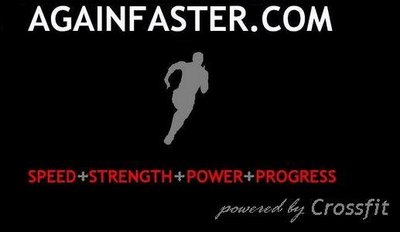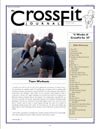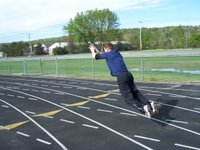A True Maximum

Successful barbell training has several components. In addition to intelligent program design and raw strength, it requires mastery of technique. Without proper technique, force is not used optimally, and an artificial performance ceiling is imposed on the trainee.
All decent coaches know this, and thus spend countless hours drilling proper movement patterns into their athletes. CrossFit is no different. “Chest up, butt back, heels down” is a refrain that I repeat dozens of times every day at CrossFit Boston, whether teaching the squat, the push press, or the thruster. My athletes are equally likely to hear “knees out” and “track the toes” as they are to breathe heavy or need a drink of water.
These cues are directed at everyone, even the most advanced trainees. Proper movement requires constant repetition and reinforcement. In this cycle of correction and reinforcement, I sometimes lose sight of the next step—teaching the proper way to express maximal strength.
Once technique is sufficiently mastered, the athlete must learn to incorporate bodily tension into the lifts. A mechanically sound lift without ample tension is necessarily sub-maximal, as tension has a synergistic effect and will allow the athlete to move a relatively greater amount of weight. This happens due to some simple physical laws.
Force is produced through muscular contraction, moving from the core to the extremities. It must travel through the body before it reaches the source of external resistance—in this case, the barbell. Some of this force is lost as it dissipates into within the body, absorbed by lax muscles and non-contributing tissue. The remaining force travels through its primary pathway, the skeletal system, finally arriving at the barbell and causing movement. Obviously, we’d like to direct as much of the original force as possible to the barbell, minimizing the amount lost within the body and maximizing the amount of weight we can lift. This is achieved through hardening the tissue around the skeletal system through tension generation. When tension is maximized, the trainee is able to express the full limits of his or her strength.
Teaching athletes to create tension is relatively simple. We focus on five areas—the lungs, the abdomen, the butt, the hands, and the feet.
The first priority is creating a rigid torso, as all barbell movements depend on the torso in one way or another. The trainee is instructed to inflate the lungs while pulling the chest upward and outward in an exaggerated display of manliness. This is a practice the old-time bodybuilders refer to as “chest expansion”, and we can be thankful that they got one thing right. It turns the heretofore non-contributing lungs into an internal brace, replacing the liability of empty space with an asset capable of transmitting force. It also serves to retract the upper back, the usefulness of which becomes obvious after completing the subsequent step. The trainee then contracts the abdominal wall and the obliques as if anticipating a blow to the stomach. This completes the hardening of the torso, as the retracted upper back will now spontaneously fire off in concert with the lats, creating a rigid structure throughout the entirety of the upper body.
Next, the trainee contracts the glutes. Tension in the glutes will simultaneously cause the lower back and the hamstrings to contract, effectively creating a bridge between the torso and the legs and turning the body into a single unit. Note that this is only done with movements that begin with concentric loading, such as the deadlift and the press. It is self-defeating to contract the glutes prior to eccentric movements such as the squat or the dip portion of the push press, as a “tight butt” will prevent the hip flexors from doing their job and pulling the trainee downward.
The final piece of the puzzle is the limbs. They represent the last opportunity for force to be lost, and must be made as rigid as possible. This is easy. Simply crush the barbell with the hands and grip the floor with the toes. The arms, shoulders, and lower legs will all contract, surrounding the limb bones with fully hardened muscle.
This sequence of events, from inflating the lungs to gripping the floor, should only take a few seconds. At this point, the trainee is burning brain cells by the moment, inflated lungs depriving the brain of precious oxygen and contracted muscles causing blood pressure to shoot through the roof. It is imperative that the lift be completed as quickly as possible. Once past the sticking point, muscular tension should be held while the inflated lungs are slowly allowed to deflate, restoring the flow of oxygen to the body. This invariably happens toward the end of the lift, as leverages become more advantageous to the trainee, and the weight becomes easier to support.
For higher repetition efforts, it is necessary to generate and release tension in a cycle, so that maximum tension occurs at the same time as maximum exertion. This is fairly intuitive once the trainee is competent at creating and maintaining tension. Inevitably, those most skilled in this practice will have the best chance of performing multi-repetition efforts at a high percentage of one-rep maximum.
Like proper biomechanical technique, tension generation is a skill that must be learned, refined, and reinforced. Repeated practice will result in ever-increasing efficiency, allowing larger loads to be lifted. Trainees are often surprised by the difference that five minutes of attention to this matter can make. Formerly latent strength manifests itself in a rash of new personal records, and I’m decried for not giving up this “secret” sooner. Now you know. Next time, take a deep breath and ride it all the way to true maximum effort.
Go faster!

Successful barbell training has several components. In addition to intelligent program design and raw strength, it requires mastery of technique. Without proper technique, force is not used optimally, and an artificial performance ceiling is imposed on the trainee.
All decent coaches know this, and thus spend countless hours drilling proper movement patterns into their athletes. CrossFit is no different. “Chest up, butt back, heels down” is a refrain that I repeat dozens of times every day at CrossFit Boston, whether teaching the squat, the push press, or the thruster. My athletes are equally likely to hear “knees out” and “track the toes” as they are to breathe heavy or need a drink of water.
These cues are directed at everyone, even the most advanced trainees. Proper movement requires constant repetition and reinforcement. In this cycle of correction and reinforcement, I sometimes lose sight of the next step—teaching the proper way to express maximal strength.
Once technique is sufficiently mastered, the athlete must learn to incorporate bodily tension into the lifts. A mechanically sound lift without ample tension is necessarily sub-maximal, as tension has a synergistic effect and will allow the athlete to move a relatively greater amount of weight. This happens due to some simple physical laws.
Force is produced through muscular contraction, moving from the core to the extremities. It must travel through the body before it reaches the source of external resistance—in this case, the barbell. Some of this force is lost as it dissipates into within the body, absorbed by lax muscles and non-contributing tissue. The remaining force travels through its primary pathway, the skeletal system, finally arriving at the barbell and causing movement. Obviously, we’d like to direct as much of the original force as possible to the barbell, minimizing the amount lost within the body and maximizing the amount of weight we can lift. This is achieved through hardening the tissue around the skeletal system through tension generation. When tension is maximized, the trainee is able to express the full limits of his or her strength.
Teaching athletes to create tension is relatively simple. We focus on five areas—the lungs, the abdomen, the butt, the hands, and the feet.
The first priority is creating a rigid torso, as all barbell movements depend on the torso in one way or another. The trainee is instructed to inflate the lungs while pulling the chest upward and outward in an exaggerated display of manliness. This is a practice the old-time bodybuilders refer to as “chest expansion”, and we can be thankful that they got one thing right. It turns the heretofore non-contributing lungs into an internal brace, replacing the liability of empty space with an asset capable of transmitting force. It also serves to retract the upper back, the usefulness of which becomes obvious after completing the subsequent step. The trainee then contracts the abdominal wall and the obliques as if anticipating a blow to the stomach. This completes the hardening of the torso, as the retracted upper back will now spontaneously fire off in concert with the lats, creating a rigid structure throughout the entirety of the upper body.
Next, the trainee contracts the glutes. Tension in the glutes will simultaneously cause the lower back and the hamstrings to contract, effectively creating a bridge between the torso and the legs and turning the body into a single unit. Note that this is only done with movements that begin with concentric loading, such as the deadlift and the press. It is self-defeating to contract the glutes prior to eccentric movements such as the squat or the dip portion of the push press, as a “tight butt” will prevent the hip flexors from doing their job and pulling the trainee downward.
The final piece of the puzzle is the limbs. They represent the last opportunity for force to be lost, and must be made as rigid as possible. This is easy. Simply crush the barbell with the hands and grip the floor with the toes. The arms, shoulders, and lower legs will all contract, surrounding the limb bones with fully hardened muscle.
This sequence of events, from inflating the lungs to gripping the floor, should only take a few seconds. At this point, the trainee is burning brain cells by the moment, inflated lungs depriving the brain of precious oxygen and contracted muscles causing blood pressure to shoot through the roof. It is imperative that the lift be completed as quickly as possible. Once past the sticking point, muscular tension should be held while the inflated lungs are slowly allowed to deflate, restoring the flow of oxygen to the body. This invariably happens toward the end of the lift, as leverages become more advantageous to the trainee, and the weight becomes easier to support.
For higher repetition efforts, it is necessary to generate and release tension in a cycle, so that maximum tension occurs at the same time as maximum exertion. This is fairly intuitive once the trainee is competent at creating and maintaining tension. Inevitably, those most skilled in this practice will have the best chance of performing multi-repetition efforts at a high percentage of one-rep maximum.
Like proper biomechanical technique, tension generation is a skill that must be learned, refined, and reinforced. Repeated practice will result in ever-increasing efficiency, allowing larger loads to be lifted. Trainees are often surprised by the difference that five minutes of attention to this matter can make. Formerly latent strength manifests itself in a rash of new personal records, and I’m decried for not giving up this “secret” sooner. Now you know. Next time, take a deep breath and ride it all the way to true maximum effort.
Go faster!




















0 Comments:
Post a Comment
<< Home